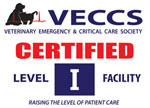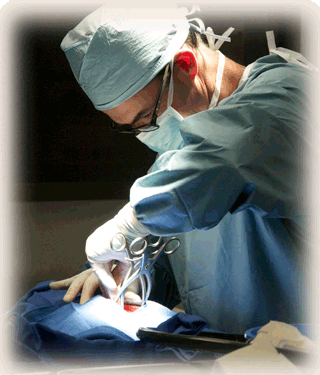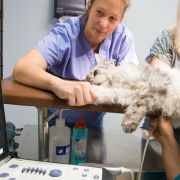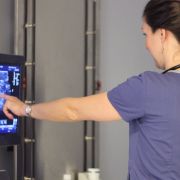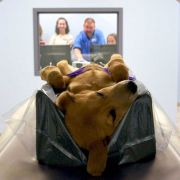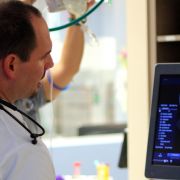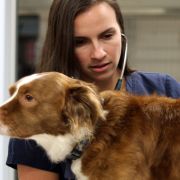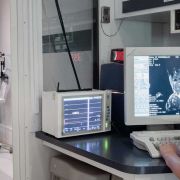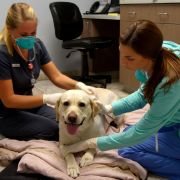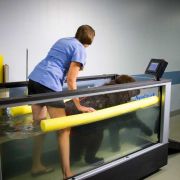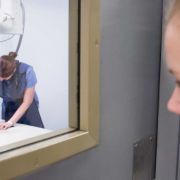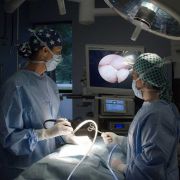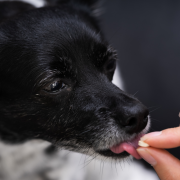A veterinary surgeon is a veterinarian with advanced training and expertise in the diagnosis and treatment of all aspects of surgical diseases in your pet. All surgeons are trained in soft tissue (abdominal, thoracic, reconstructive, oncologic), neurological and orthopedic surgery. Some surgeons have a particular interest or focus in one of these areas of surgery, such as orthopedics or minimally invasive procedures. Board certified surgeons are skilled in anesthesia and pain management as well. In addition to providing surgical care to their patients, CVRC's surgery department works collaboratively to support the other services at CVRC, as well as with your family veterinarian.
We are excited to offer a full physical rehabilitation facility onsite at CVRC to help obtain the best possible outcomes and return to function.
A board certified veterinary surgeon is a veterinarian who has obtained intensive, additional training in surgery and has been certified by the American College of Veterinary Surgeons (DACVS). The advanced training and education required for this certification includes:
- A veterinary degree (three to four years of undergraduate college, followed by four years of veterinary school).
- One year rotating internship in veterinary medicine and surgery.
- Three years of advanced surgical training (residency).
- A series of rigorous examinations covering all aspects of general medicine and surgery.
Philosophy:
When your pet needs the care of a veterinary surgeon, years of intensive training and education will be focused on helping your pet to enjoy the best quality of life possible or return to function after injury. With appropriate expertise, diagnostics tools, care, and follow-up, we are excited to offer the very best surgical treatment options for your pets.
What is an emergency/specialty hospital and how is it different than my primary veterinarian?
A specialty hospital does not offer any routine or preventative care. Our veterinarians have advanced training in specific disciplines such as surgery, oncology, internal medicine, emergency and critical care medicine, physical rehabilitation and neurology among others. We also have equipment that most primary veterinarians don’t have such as CT scans, MRI, endoscopic equipment, and specialized surgical tools. We work closely with your primary veterinarian to offer these services to you.
What soft tissue procedures are offered?
- Abdominal Surgery
- Gastrointestinal surgery
- Enterotomy/Gastrotomy (foreign body removal)
- Mass removals
- Cholecystectomy (gallbladder removal)
- Cystotomy (bladder stone removal)
- Gastropexy (treatment or prophylaxis for GDV)
- Splenectomy
- Biopsy
- Liver shunt ligation
- Reproductive procedures
- Gastrointestinal surgery
- Thoracic Surgery, including:
- Mass removal
- Biopsy
- Pericardectomy
- Lung lobectomy
- Congenital cardiac/vascular defects
- Persistent right aortic arch (PRAA)
- Patent ductus arteriosis (PDA)
- Oncologic Surgery
- Mass removal
- Amputation
- Biopsy
- Chemotherapy bead implantation
- Reconstructive Surgery, including:
- Skin flaps
- Hernia repair
- Wound management
- Ear, Nose and Throat Surgery, including:
- Brachycephalic syndrome
- Laryngeal paralysis
- Total ear canal ablation
- Endocrine Surgery
- Urogenital Surgery
- Trauma Surgery
What orthopedic procedures are offered?
- Fracture repair
- Internal fixation
- External fixation
- Minimally invasive fixation
- Surgical management of cruciate ligament tears
- Lateral suture
- Tibial Plateau Leveling Osteotomy (TPLO)
- Luxating patella correction
- Growth deformity correction
- Joint dislocations
- Open (surgical) reductions
- Closed reductions
- Oncologic surgery
- Amputation
- Maxillectomy
- Mandibulectomy
- Biopsy
- Mass Removal
- Diagnosis and medical/surgical management of hip dysplasia
- Juvenile pubic symphysiodesis – Treatment for dogs with hip dysplasia that are very young
- Triple pelvic osteotomy – Treatment for dogs with hip dysplasia up to about 1 year old
- Femoral head and neck ostectomy (FHO)
- Diagnosis and medical/surgical management of forelimb lameness
- Elbow
- Shoulder
- Platelet rich plasma therapy
- Arthritis management, pain management and weight loss
Physical rehabilitation for return to function after injury, disease, or surgery.
What neurosurgical procedures are offered?
- Intervertebral disc surgery (disc protrusion)
- Ventral Slot
- Hemilaminectomy
- Dorsal laminectomy
- Wobbler syndrome (surgical and medical management)
- Lumbosacral disease (surgical and medical management)
- Tumor removal and biopsy
- Spinal Stabilization of fracture or luxation
- Spinal Fractures
- Congenital instability/luxation
What minimally invasive procedures are offered?
- Arthroscopy
- Elbows
- Shoulders
- Stifles (knees)
- Laparoscopy
- Biopsy of abdominal organs/tissue
- Spays and neuters
- Gastropexy
- Thoracosopy
- Pericardectomy
- Biopsy of thoracic organs/tissue
- Minimally invasive fracture repair (MIPO)
Imaging and Other Diagnostics
- Digital Radiography
- Fluoroscopy
- Computed Tomography (CT scan)
- Myelography
- Magnetic Resonance Imaging (MRI)
What should I expect during my visit?
If you are a new client to CVRC, we encourage you to fill out our New Patient Registration Form ahead of time online, or bring the form with you. Otherwise, please arrive to your appointment approximately 10 minutes early to complete this form in our office. If you are transferring for continued care from your primary veterinarian, please come to CVRC at your earliest convenience.
Surgical consultation usually begins with your family veterinarian diagnosing a disease or condition that requires advanced expertise, diagnostics, therapeutics, or surgery. A full history, medical record review, and complete physical examination are performed. After examination and discussion, an initial treatment plan will be presented for the diagnostic workup and/or treatment.
Our surgeon will communicate with you during the work-up or treatment process to keep you informed on your pet's progress. We will also communicate with your primary veterinarian during this process to ensure a collaborative treatment plan for the care of your pet. Upon discharge, you will be given a printed visit summary with the diagnosis, treatment recommendations, and follow up care. A full report will be sent to your family veterinarian the same day. We welcome your progress reports, questions and concerns any time and will maintain an ongoing relationship with your primary care doctor to ensure the best experience for you and the best care for your pet.
What should I bring to my visit?
First and most importantly, bring your pet to all visits. You may be instructed to withhold food and water from midnight the night before your appointment to allow for certain diagnostic testing. If your pet is on any medications, please let us know and we will advise you whether or not to administer them on the morning of your appointment. Also, please bring a list of all medications, strengths and dosages, or the pill vials. Records, including recent laboratory work, can be faxed or emailed to us from your primary care veterinarian prior to the appointment. If your pet has had any x-rays taken recently, please bring those with you as well. We can request records and digital x-rays on your behalf from your family veterinarian once you have scheduled a visit with us.
Do I need a referral?
While referrals are recommended to see one of our specialists, they are not required. It is always better to speak to your veterinarian about a referral so we can collaborate with your veterinarian to ensure the best care for your pet.
Will you keep my family veterinarian informed of the care my pet receives at CVRC?
We work closely with your primary veterinarian and ensure they receive copies of all medical records. We also communicate via phone and they have the ability to access a portal into our medical record system.
Does my pet need an MRI or CT Scan?
Consultation with our surgeon, review of history, full physical examination, and discussion with you will dictate the necessity of either MRI or CT Scan. Please be aware that CT and MRI overlap in their use, and the decision of one modality over another is based on desired tissue resolution, availability, cost, anticipated findings and patient stability.
Can my pet have an MRI or CT Scan the day of my appointment?
Depending on the nature of your pet's neurological issue, time of your appointment, and schedule for the day, we can often offer imaging after your appointment. Please let us know when scheduling your appointment if you know at that time that you would like this option.
What is a CT Scan?
CT Scan is a non-invasive imaging modality that performs 360◦, cross-sectional imaging of our patients. CT Scan uses x-ray technology to acquire these images, but does so with vastly increased detail and sensitivity, allowing us to visualize structures as small as 1-2mm in size.
Our helical, 4-slice CT scanner is able to perform imaging studies much faster than older, conventional scanners that are often found in veterinary medicine. Using newer equipment and software, we are able to perform most studies in less than a minute (actual scanning time). This reduction in time also comes with increased quality and sensitivity: advantages that translate to shorter anesthetic times for our patients, even the ability to perform some studies under a light plane of sedation.
How is CT performed?
After being thoroughly examined by one of our doctors, your pet is sedated or anesthetized and placed on the CT imaging table. The CT technician positions the patient and programs the CT computer for the desired type of study. The patient table then advances through the CT gantry (which is a large, donut shaped opening) while an x-ray tube and sensors rotate at high speed around the patient. Usually, the scan is performed twice, the second time with administration of an intravenous contrast agent that highlights blood vessels and other structures. These images are reconstructed on a computer console attached to the CT machine, then reviewed by our specialists.
What is CT used for?
Brain – Trauma with suspected fracture, acute intracranial injury in an unstable patient
Spine – fractures, mineralized disc rupture, neoplasia
Nasal Cavity & Sinuses – Chronic nasal discharge and/or sneezing, nasal distortion/deformation, neoplasia
Orbit/Ocular – Orbital trauma with suspected fracture, neoplasia
Head/Neck – Dental-related neoplasia, head/neck trauma with suspected fracture
Thorax – Metastatic screening, primary lung neoplasia, pneumothorax, lung lobe consolidation, chronic pneumonia, pleural effusion, mediastinal disease
Abdomen – Upper urinary tract evaluation, ectopic ureter, renal/ureteral calculi, clarification and surgical planning for large organ masses ( including liver, spleen, kidney, GI tract), investigation of suspected portosystemic shunts
Musculoskeletal – Elbow dysplasia, suspected incomplete ossification of the humeral condyles, complex fractures
Neoplasia – Surgical planning for tumor removal or debulking, Lung metastasis screening
Cardiovascular – Pulmonary embolism
Other – General trauma
Does my pet need to be sedated or anesthetized for a CT Scan?
Anesthesia or sedation is required to perform a CT Scan. We use the most up to date and safest anesthetic agents, preanesthetic laboratory screening, tailored anesthetic protocols, and state of the art monitoring equipment to ensure safety for your pet before, during, and after anesthesia.
What is MRI?
Magnetic Resonance Imaging (MRI) is an advanced, non-invasive, non-radiating imaging modality that has become commonplace in human medicine, and has rapidly expanded into the veterinary field.
MRI uses a strong magnetic field that aligns protons of the body tissues within the field. A radio frequency signal (RF) is then applied to the field which disrupts the alignment of these protons, after which they return to their original state. The RF signals are collected by a receiver (called a coil) and then transmitted back to a computer, which creates visual images from this information.
These images are easily constructed in axial, dorsal, sagittal and oblique planes for review by the clinician or radiologist. MRI is often performed using an intravenous contrast agent that enables us to better visualize certain structures and abnormalities. MRI yields the highest level of soft tissue detail compared to other imaging modalities. This sensitivity allows for highlighting desired structures or tissues by adjusting settings on the MRI machine.
How is MRI performed?
After being thoroughly examined by one of our doctors, your pet is anesthetized and placed in the MRI. The MRI technician positions the patient and programs the MRI computer for the desired type of study. An MRI study typically takes 30 minutes to one hour to complete, and requires general anesthesia, as the animal must be perfectly still for the duration of the study. The images are reconstructed on a computer console attached to the MRI, then reviewed by our specialists.
MRIs are performed by technicians who have received advanced education and training in magnetic resonance imaging.
What is MRI used for?
While MRI can be used for imaging a wide variety of body tissues, for most veterinary applications, it is used to image diseases or disorders of the brain, spinal cord, or peripheral nervous system. It may also be used for imaging of muscles, tendons, and ligaments.
Does my pet need to be sedated or anesthetized for an MRI?
Anesthesia or sedation is required to perform an MRI. We use the most up to date and safest anesthetic agents, preanesthetic laboratory screening, tailored anesthetic protocols, and state of the art monitoring equipment to ensure safety for your pet before, during, and after anesthesia.
Will my pet be in pain after surgery?
We are very sensitive to the comfort level of your pet. Patients are vigilantly monitored for comfort (as well as other vital parameters), and a multimodal approach to pain management is used with combinations of safe medications used to allow for as comfortable a recovery as possible.
Will my pet need to stay overnight?
Depending on the nature of your pet's disease or injury, the diagnostics or treatments performed, and their timing, your pet may or may not need to stay overnight. Our doctor or veterinary nurse will discuss the expected hospital stay during your visit or admission to the hospital. Many surgical procedures will necessitate an overnight stay for monitoring of vital parameters, medication delivery, and ensuring patient comfort.
Is someone going to be caring for my pet 24 hours a day?
All patients have round-the-clock care. We always have doctors and veterinary nurses on premises to monitor and care for your pet. No pet is ever left unattended.
Can I visit my pet while they are hospitalized?
We always allow owners to visit with their pets. Please call and speak with your doctor or nurse so we can coordinate a time that is best for your pet and you. We try to limit visits to twice a day for 15 minutes as to not interfere with your pet’s treatment. It is generally discouraged to visit on a day when your pet underwent general anesthesia as sometimes this can be disruptive to their recovery.
If you feel there is an extenuating circumstance, please discuss this with your doctor.
When is it best to call to check on my hospitalized pet?
It is best to call after 10 am to receive an update. The doctors are in rounds from 8 am - 9 am every morning. After rounds, every patient is examined by their doctor. If the situation warrants, we will call you before this time.
Can I bring special items from home (blankets, tee shirts, toys, etc.) to keep with my pet during their hospital stay?
Yes, you are welcome to bring things from home to make your pet feel more comfortable. Please note, however, we cannot always guarantee the return of these items as they may get soiled, lost or damaged.
Should I bring my pet's prescription medications and/or prescription food when my pet is being admitted to the hospital?
In an emergency situation, the priority is for you and your pet to get to CVRC. Once it is determined that your pet is going to be hospitalized, you may bring all prescription medications your pet is currently receiving. We carry most common medications if this is not feasible. Our doctor will determine if these should be continued during your pets stay.
We have a full range of diets to feed our hospitalized patients. However, if your pet is on a prescription or special diet we will gladly feed that if you provide it for us.
Does my pet need to have their activity level restricted after surgery?
Yes, generally a minimum of 2 weeks is needed to allow incisions to heal. Additional restrictions will be based on the specific procedure performed. Please refer to your discharge instructions for specific information.
Will my pet be on medications after surgery?
Many surgical patients are discharged with medications to continue at home. These medications help with patient comfort (pain medications, anti-inflammatory medications), but sometimes antibiotics or other medications are necessary.
Is it normal that my pet has not had a bowel movement after being hospitalized?
It is common for pets to not have a bowel movement for the first 24-72 hours after returning home. However, this is not the case with all conditions so please refer to your discharge instructions.
The changes in their defecation pattern are often due to a different eating schedule in the hospital and some medications can contribute to this. If you are concerned, your pet seems uncomfortable, or is trying to defecate but is unable (straining) please call us.
Is it normal that my pet has been urinating more frequently after being hospitalized?
It is common for pets that were on IV fluids to have increased urine production. Therefore, they may need to urinate more frequently.. This may last for 24-48 hours. If they are straining or not producing urine, please call us immediately.
Is it normal that my pet has not urinated, or is having trouble urinating, after being hospitalized?
This is not normal as most animals will urinate within 24 hours of returning home. If your pet is not urinating, or having difficulty while urinating, please call us immediately.
Is it normal that my pet has slept all day after being hospitalized?
Pets sleep cycles in the hospital environment are altered so it is not uncommon for them to be tired when returning home. This may last for 24 hours. If your pet appears listless, unable to ambulate, or you are concerned please call us.
Will my pet need to wear an e-collar (lamp shade type) after returning home from the hospital?
An e-collar prevents a pet from licking an area we want to protect until it is healed. This may be a wound, irritation or an incision. Please refer to your discharge instructions for specifics.
When do my pet's sutures/stitches need to be removed?
Generally we remove sutures 10-14 days post placement. Please refer to your discharges instructions for specifics.
Do I need to pay to have my pet's sutures removed after having surgery at CVRC?
Suture removal is done complimentary for all patients that had a surgical procedure. If further procedures (x-rays, bandage changes, additional diagnostic tests, etc.) or additional medications are indicated there will be applicable fees.
Should my pet have physical rehabilitation after injury or surgery?
Consultation with your pet’s surgeon, review of history, full physical examination, and discussion with you will dictate the necessity of physical rehabilitation. Many patients respond very well to physical rehabilitation and have a faster return to function after injury or surgery. We have several certified rehabilitation specialists who collaborate with our surgical team to ensure the best outcome for your pet.
My pet feels warm to the touch. Does that mean he/she has a fever?
Not necessarily. Dogs and cats have a higher body temperature than people so they often feel warm. You can purchase a rectal digital thermometer (doesn’t need to be animal specific) and obtain your pet's rectal temperature. This is the most accurate assessment. Normal temperature for dogs and cats is 99.5—102.5 degrees Fahrenheit.



